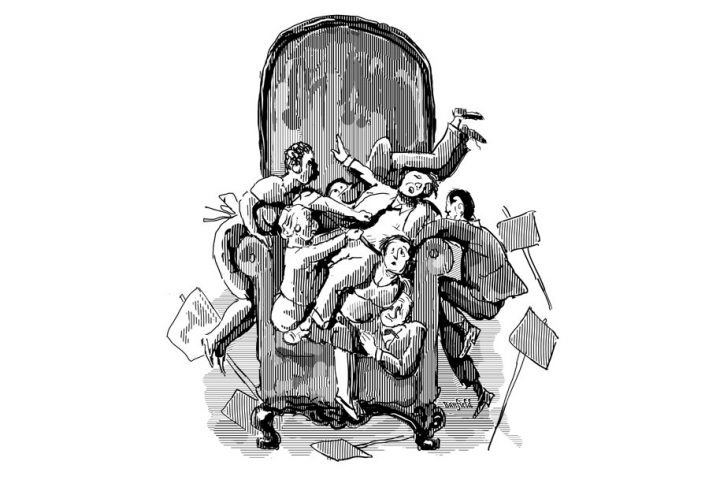One would hope that the genius of science, the action of nature, and the conduct of the people have checked the pandemic that at this writing has so disrupted the world. Checked or not, like all God’s dangers, its lesson, which is usually ignored, is prudence. We have not been prudent.
But what if you could go back in time, say 15 years, knowing with certainty of the approach of a viral pandemic such as at present? You would have a good idea of what to recommend:
The creation of a network of regional centers throughout the United States, perhaps a dozen, each with both an institute for research into emergent pathogens and an adjoining complex for the rapid manufacture and distribution of curatives and vaccines.
The stockpiling of medical supplies such as masks, gloves, gowns, sterilization equipment, and ventilators in particular. In regard to the latter you would possess the hindsight to warn of the future Obama Administration’s tax on medical devices.
Immense quantities of fully supplied, equipped, ready-to-assemble, high-capacity field hospitals and the trained reserves to man them, strategically pre-positioned for fast and efficient deployment.
The abandonment of sufficiency in regard to the numbers per capita of hospital beds, ICU and isolation wards, doctors, nurses, medical technicians, etc., in favor of a surplus that in normal times might be judged excessive and uneconomical but in times of existential stress would be essential. And given that the laws of economics cannot be repealed, the widespread increase in the supply of medical goods (doubling or more the output of medical and nursing schools, building more hospitals, etc.—something far cheaper than a crashing economy or the louche trillions ejaculated in a panic of arresting it) would halt their heretofore galloping unaffordability.
Lessening or eliminating the taxation of medical and pharmaceutical innovations and industries on condition that they address certain lines of inquiry in regard to public health, such as emergent pathogens and orphan drugs, that otherwise would not be economical in the short term. Capital would flow in, and great advances would be lifted on its flood. Oberlin, the Sierra Club, and countless nitwit “arts” and supposedly nonpolitical non-profits are tax-privileged. How many lives and nations do they save?
A time machine, however, would not have been necessary. In fact, 15 years ago, such recommendations were presented in substantive detail. The science was run by the now famous Anthony Fauci, the Centers for Disease Control, and other experts. And the specific measures were not simply tossed into the wind but, rather, represented in an overall philosophical, moral, and historical context. And their advocate was neither obscure nor powerless.
He was a world-renowned physician, simultaneously the Majority Leader of the United States Senate and considering a presidential run. Senator William H. Frist, M.D., enthusiastically and wholeheartedly took up the cause of warning of and preparing for antigenic-shift pandemics such as COVID-19. He made the case repeatedly, at length, and in depth, among other places, in the Senate, at Harvard Medical School’s most important annual lecture, at Davos, and at the White House, where he did not have to speak to low-level staffers. Suffice it to say, he was not without influence.
* * *
But neither the public nor the powers that be evinced the slightest interest. Although some medically oriented publications took notice, and to its credit, in its Fall 2006 issue the Claremont Review of Books published “The Worst Generation Faces the Greatest Peril,” associated op-eds were rejected by prestigious newspapers that didn’t have a clue.
Had Senator Frist’s warnings been heeded we would undoubtedly be in far better circumstances now, even if not entirely in the clear. But human nature is imprudent absent the lash, favoring momentary delights over arming for future trials. As empires mature, fatten, and degenerate, their peoples famously become addicted to luxury, indolence, entertainment, and drugs. Warnings are detested and Cassandras ignored.
Although often associated with the free market because it is the free market that produces the wealth that can corrupt, lack of prudence has little to do with economic systems as opposed to culture and historical experience. Given so many variables, one very rough proxy for cultural prudence can be derived from saving and borrowing rates. Poorer countries in the main are forced to prudence in borrowing and imprudence in saving, but some are exceptions. With only a $17,000 per-capita GDP, Hungary’s household debt to disposable income ratio is 45%, its savings rate 12%. Canadians, with almost three times Hungary’s per capita income, borrow twice as much and save one-fourth as much. Not surprisingly, the Germans and Japanese, perhaps smarting from the imprudence of starting and losing wars, are the champions. With incomes similar to Canada’s, they borrow half as much and save four and six times as much, respectively. Somewhere and not at all commendably in the mid-range, the U.S. saves two thirds as much as the Germans and borrows one and a half times more.
What a more complete analysis shows is that, as in some beers, in most of the rich economies personal and state fiscal policies are tall on froth and short on liquidity. The peoples of the West have been so long separated by multiple generations from existential struggles and appropriate respect of mortality that they emulate the grasshopper and have contempt for the ant.
Simply stated, so as—we imagine—to be richer, we have insufficiently attended to things like defense and public health, and for that, as certainly as day follows night, we will be so much the poorer materially and in spirit when our romance with imprudence becomes a marriage with suffering. Unless of course we change, but don’t hold your breath.






